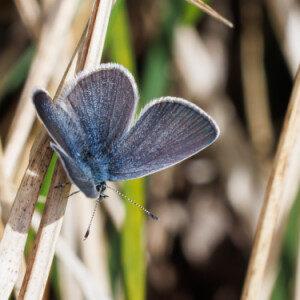Small
Everything I photographed today was pretty small, but I think these are two of the littlest. The featured photo is a male Zebra Jumping Spider (Salticus scenicus), which comes in at only about 5mm long, and the second image shows a Small Blue butterfly (Cupido minimus), which is the UK's smallest native butterfly, with a wingspan of around 2cm.
I found the spider on my grandmother's peony during a first-thing stroll around the garden. This was interesting, because it's a long way - as the tiny spider jumps - from any of the places where I regularly find females of this species. The females, which are slightly longer, and also broader and more robust, tend to hang out on the house or garden walls, and on a couple of large honeysuckles we have in the yard and by the garage. Presumably this is also where they lay their eggs, and where their spiderlings first start to develop, but at some point this little chap has taken himself off into the depths of the garden, where he was living his best solitary life when I spotted him hunting tiny flies around the peony buds. This is a sensible move, because there are many creatures that wouldn't give a second thought to making him into a meal, and among them are female Zebra Jumping Spiders.
If you view this image full-screen, you should be able to see that, tiny as he is, this spider seems to be unusually well-endowed with appendages. As well as the eight legs you'd expect, he has two shorter leg-like structures below his head, and behind those, two large, shiny black ones. The leg-like structures are called pedipalps, and they mainly function as sensory organs, but in males they're also used to transfer a sperm packet to the female during copulation. The large shiny black structures are called chelicerae, and you can loosely think of them as jaws; they contain the venom glands, and work together like the blades of a pair of scissors to drive the spider's inward-facing fangs into a victim. If you compare this image with one I took a few years ago of a female, you'll see that the male's chelicerae are huge compared to hers, and this again is connected with reproduction (as well as being a useful distinguishing feature from the human point of view). When he's ready to mate, this male will use his chelicerae in largely ritualistic battles with rival males to determine supremacy, and if he wins the right to approach a female he'll display them again to her, in what the British Ararachnological Society describes as a jerky, zig-zagging dance. If he impresses her she'll squat down and allow him to climb on her back; if not, she might just decide to have him for lunch.
The Small Blue butterfly isn't as interesting, but they are quite interesting, and I'm posting this one (which again I think is a male) to mark my first visit in two years to the Butterfly Conservation reserve at Prestbury Hill. Every time I visit this site I like it a bit less than I did before, and I think I'm genuinely getting a bit old to be scrambling up and down loose limestone scree slopes that in places feel close to vertical, but it's the nearest place to home that boasts a decent number of the butterfly species I think of as the Small Earlies - so, needs must. Today I only found two of my targets - I got some extremely average shots of Dingy Skippers, as well as the Small Blues - but I missed out on Marsh Fritillaries, Green Hairstreaks, and the Duke of Burgundy. I knew that the Hairstreaks are out, but they're tricksy little beasts, and having searched all the sections of the reserve where I've found them before, I concluded that they weren't liking today's breezy conditions and had decided to stay at home in the warm. Imagine my amusement later in the day, when I saw photos on my socials taken by someone who was on site at the same time, of Green Hairstreaks feeding on the gorse on the other side of the slope: the little blighters have only gone and moved. Still, I'll have to go back anyway, for the Dukes and the Frits - so, next time, Green Hairstreaks. Next time...
There's more on the Small Blue here - though I think they may have forgotten to mention the quite interesting fact (not to mention useful, if you happen to be looking for some near a dog-walking route) that they simply adore poo.


Comments
Sign in or get an account to comment.


